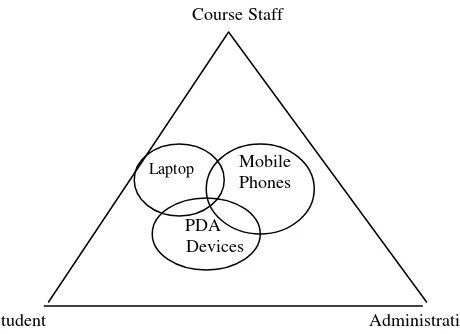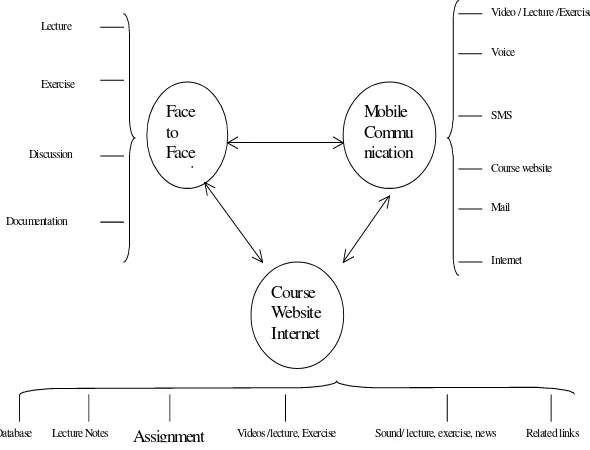FRAMEWORK FOR MOBILE LEARNING SYSTEM BASED ON
EDUCATION COMPONENT
by
Ali Mostakhdemin-Hosseini,
Jari MustajärviAbstract: Developing applications for mobile devices is fundamentally different than for desktop. Mobile devices with low computation power and other restrictions such as memory, screen size, and resolution, etc. require extensive effort for developing new services. In the meantime the amount of mobile devices, such as mobile phones, PDA devices and laptops is widely increasing among students and staff. Utilizing these devices in the education processes has a great impact to students and staff. It enables students and teachers to have access to different resources independently of time and place. In this paper the process of developing mobile learning services based on education components [1] is discussed.
Keywords: E-learning, M-learning, mobile applications, and education components
INTRODUCTION
The capabilities of mobile devices, such as mobile phones, have improved in recent years. New phones are capable of exchanging voices, text, pictures and video. In addition, the wireless network provides high-speed connections with low costs to mobile subscribers. With the existing technology both in mobile devices and in the network these devices are capable in offering more services and can be utilize as an additional tool.
As McClard [2] has stated, the portable devices are not a replacement for PC. This paper considers mobile devices as an additional tool in the education process that should be utilized with other existing tools.
In the recent years web applications have become one of the main tools in the education process. Teachers utilize web for different purposes e.g. as an informative tool, for providing assignments etc. Brusilovsky [1] has divided the needs of the virtual university into four components:
1. Presentation: Functions related to new material 2. Activities: Functions related to students activities
3. Communications: Functions related to students and staff interaction. 4. Administration: Functions related to registering, record keeping,
payment etc.
Figure 1. Overview of m-learning structure
FEATURES OF MOBILE LEARNING SYSTEMS
The mobile learning system described by the following features:
• Allows users to have access to course resources impendent from time and place
• Allows authenticated users to have access to the system
• Allows users to have access to the resources in different formats (voice, text, picture and video)
• Allows the reuse of material
• Allows users to carry out the functions defined as an education component.
• Offers flexible environment in which other services and components can be added.
However we have to keep in mind that content of the mobile devices is based on their capabilities.
User study and concept development for mobile learning environment
The user study was carried out by conducting semi-structured interview with the course organizers at IPS (Information Processing Science) and TML (Telecommunications Software and Multimedia Laboratory) departments at Helsinki University of Technology. The gathered data during user study phase was analyzed and the actions and their frequencies are classified in a table. By extrapolating the
Laptop Mobile Phones
PDA Devices
Course Staff
result from the analysis, each action starting from highest frequencies was evaluated with different mobile devices (mobile phones, PDA and laptop) and graded. Based on this method the distribution of services to each device was graded and evaluated. These processed were carried out for the entire actions in the classification table until all actions and their appropriate device/s were defined.
The actions were then divided based on education components By knowing which actions are distributed to what device/s and also by knowing which device is capable of performing an action or the type of formats. These steps reveal the overall framework of the mobile learning system.
Several issues needed to be considering for developing the services:
1. The aims of the service: what the service should accomplish with respect to the user’s task?
2. What kinds of data should be exchanged?
3. Service environment: what service is convenient to which mobile devices?
4. The service satisfaction levels: what are the main emphasizes in service?
5. The technology decision: for which technology the prototype will be implemented?
The design and the role of different tools are presented in the following figure.
Face
Video / Lecture /Exercise
SMS
Lecture Notes Assignment Videos /lecture, Exercise Sound/ lecture, exercise, news Related links Database
A prototype was designed and tested based on the divided actions and existing technology. The implementation of the proto was based on the three tier- architecture.
Framework of the Mobile Learning Systems
Mobile learning system development is based on three main domains: mobile usability, wireless technology and e-learning system.
Mobile usability: the mobile usability refers to validating the services in each mobile device that involved in the mobile learning system. This includes the type of the mobile device, the features of the mobile and the mobile content design and evaluation method.
It is essential to consider the following issues in developing the mobile learning system:
1. The nature of the services (long/short content)
2. The type of offered services (Voice, text, picture and moving picture) 3. The services’ features and characteristics (long text required bigger
screen size)
Wireless network: wireless network infrastructures, capabilities and the cost of services. This include also the operator rolls, such as the data rate, QoS security etc.
The wireless network requires the consideration of the following issues in the development process:
1. The existing network service will influence the types of the services 2. The cost of the service plays an important role
E-learning system: The needs of virtual learning and e-learning components and system.
From the E-learning system point of view the following are important issues in the development process:”
1. The e-learning platform will influence greatly the mobile learning system (adaptive systems are more complex then the typical e-learning system)
2. User groups will influence the selection of e-learning types and also distribution of services to the mobile devices.
Challenges of System Implementation
The main challenges which with the current mobile learning system is listed as follows:
1. Developing a system based on object delivery (Teachers reuse the material developed previously).
2. Adaptive content distributions (Providing content to the users based on their preliminary knowledge).
3. Extend the virtual tag service to the communication component where user leaves virtual message in some designated area for other appropriate groups.
4. Current PDAs, and Palms require some applications to be installed in advance
5. Integration of the system as whole that support all the framework features.
6. Mobile devices’ input/output capabilities. Even though the screen size and the quality of the displays have improved, still the input is slow and tedious. However an external keyboard for PDA devices speeds up the writing, which helps the users considerably.
7. Access to the mobile devices and the network cost.
SUMARY:
REFERENCES:
[1] Brusilovsky Peter & Philip Miller. Course Delivery System for Virtual University. Carnegie Technology Education, 4615 Forbes Avenue, Pittsburgh, PA 15213, USA.
[2] McClard & Sormers P; Unleashed web tablet integration into the home; proceedings of the CHI 2000 conference on Human factors in computing systems, page1-8 (2000).
Authors:
Ali Mostakhdemin-Hosseini, Department of Information Process Science,
Helsinki University of Technology, 02100 ESPOO, Finland, email:amir@cs.hut.fiJari Mustajärvi, Principle Lecturer, Häme Polytechnic Forssa unit,

